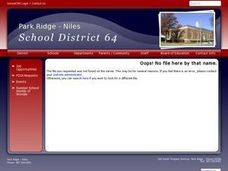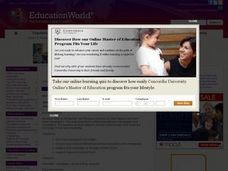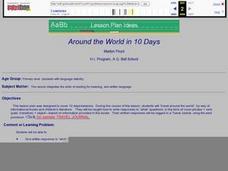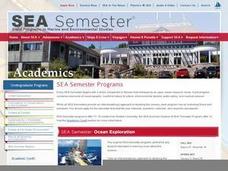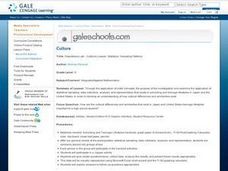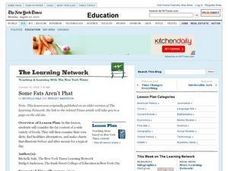Curated OER
Parts of Speech
Nouns, verbs, pronouns...they're all covered here! This presentation gives a detailed look at each part of speech, but know that you cannott skip slides or start at any slide except for the first. Create a guide to keep your class...
Curated OER
Portraits, Pears, And Perfect Landscapes: Investigating Genre in the Visual Arts
Differentiate between the various genres in the visual arts world, particularly in Western painting. Your class can view and discuss, in small groups, paintings published on the National Galleries website. Then each student individually...
Curated OER
An Author Report on Beverly Cleary
Students examine Beverly Cleary as a reader and an author. They write a letter to Beverly Cleary that details their personal journey as readers and writers after reading her work and keeping a reading journal.
Curated OER
What Are The Properties of Sea Water?
Ninth graders conduct research on the subject of sea water. They use a variety of resources to obtain information. There are helpful resource links listed in the lesson. In conjunction with the research students make inquiry of the...
Curated OER
Writing Newsletters!
A reading of Gail Gibbons’ Deadline! leads to a discussion of the differences between newspapers and newsletters. Class members then choose a favorite topic and create the front page for their own newsletter.
Curated OER
Noncombatancy and the Seventh day Adventist Church
Upper graders investigate how the Seventh Day Adventists are objectors to the practice of war. The lesson covers the Civil War and examines the church's position about the practice of war. The research extends to modern wars and learners...
Novelinks
The Devil’s Arithmetic: QAR Strategy
Asking questions about the text is an important way for kids to become critical readers. Use a QAR activity based on The Devil's Arithmetic to help learners decipher between questions that are right there, between the author and the...
Curated OER
Around the World in 10 Days
Students engage in producing responses to "what" questions and their written responses will be recorded in a Travel Journal. They produce their respones using a word processor. This instructional activity is very detailed and a rubic is...
Cornell University
Beam Focusing Using Lenses
Explore optics using an inquiry-based experimental approach! Young scholars use a set of materials to design and build a unit capable of focusing a beam of light. They experiment with different lenses to determine the best approach to...
Curated OER
Water 1: Water and Ice
Young scholars explore the states of water. In this science lesson, students use observation, measurement, and communication skills to describe water as it changes from a solid to a liquid.
Curated OER
Erupting Volcanoes!
Students examine the causes of earthquakes, volcanoes, and floods, and explore how these events shape the surface of the earth. In this erupting volcanoes lesson plan, students create a volcano model of their own, make observations...
Curated OER
Portraits, Pears, and Perfect Landscapes: Investigating Genre in the Visual Arts
Young scholars define genre in the visual arts, particularly in Western painting and explain the differences between subject and genre. The genre of a variety of works of art is identified.
Curated OER
How Do Artists Effectively Relate Historic Events?
Students explore African American migration. In this black culture and history lesson, students use a map to identify northern and southern states in which African Americans lived in the 1900s. Students observe and describe objects and...
Curated OER
Hiroshima: Question Answer Response Strategy (QAR)
“The crux of the matter is whether total war in its present form is justifiable. . .” After reading “The Aftermath,” the final chapter of Hiroshima, class members use a Question Answer Response (QAR) strategy to reflect on issues raised...
Curated OER
Creature From The Deep
Students become familiar with oceanography terms by writing an oceanography horror story.
Curated OER
Populations Lab - Cultures Lesson: Statistics / Sampling Patterns
Ninth graders examine the application of statistical sampling, data collection, analysis, and representation that exists in schooling and teenage lifestyles in Japan and the United States.
Jen London
Julius Caesar Funeral Speech Essay Assignment
"Romans, countrymen, and lovers! Hear me for my cause." "Friends, Romans, countrymen, lend me your ears!" As part of a study of William Shakespeare's Julius Caesar, individuals as asked to compare the funeral speeches of Brutus and...
All Things PLC
Glossary of Key Terms and Concepts
Considering creating a Profession Learning Community at your school? Here's a seven-page glossary of key terms and concepts, everything from action orientation and adaptive to values and vision, that all members should know to...
Curated OER
How Does the Air Get Polluted?
Students listen to or read a story that introduces awareness of environmental issues and in particular pollution.
Curated OER
Blubber: Discussion Guide
Students read Blubber by Judy Blume. In this Blubber discussion lesson, students answer pre-, during, and post- reading of the novel to assist them with comprehension. Themes addressed are problem solving, perspectives, leadership, and...
Curated OER
A to Z Quiz
In this alphabet worksheet, 5th graders answer 26 general knowledge questions in which the answers begin with each letter of the alphabet, answers included.
Curated OER
Some Fats Aren't Phat
Young scholars examine nutritional information on various food labels and then consider the nutritional value of the foods in their own diets. They create posters illustrating their diets "before" and "after" they considered their fat...
Curated OER
Inside Information
Students research and write reports about inventions and inventors. They develop graphic organizers to organize their information, and create reports on the impact of inventors and inventions.
Curated OER
Dinnertime On The Reef
Learners identify the main parts of a coral reef. They describe a coral reef food chain.


